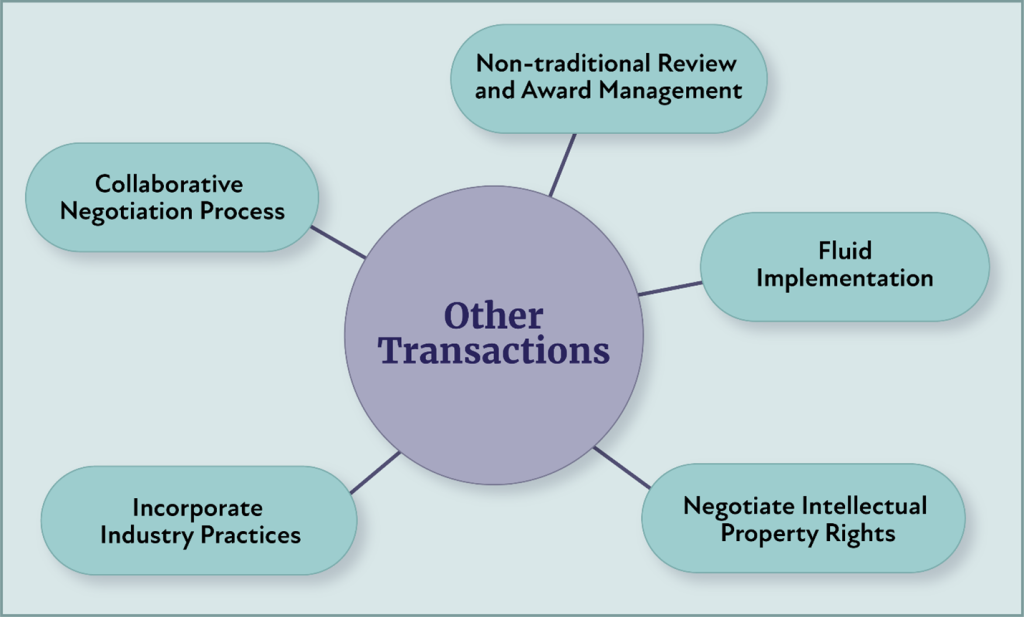9 Comments
You have likely heard about NIH establishing one of the most diverse health databases in history, aiming for at least a million participants. What about our search for new, more targeted pain treatments? Maybe the long-COVID cohort study? Or our cloud computing activities to enhance data access? Aside from these all being quite ambitious projects, they have something else in common. They are all supported through one of NIH’s Other Transactions Authorities.
What does this mean? “Other Transactions” are not grants. They are neither contracts nor cooperative agreements. Other Transactions are a unique type of legal funding instrument. Generally, these awards are also not subject to the Federal Acquisition Regulation or grant regulations (unless otherwise noted for certain provisions in the terms and conditions of award). They are, however, subject to the Other Transactions Authority that governs the initiative, as well as applicable legislative mandates.
Through unconventional processes, Other Transactions allow us to address rapidly evolving research areas, especially those that are multi-disciplinary or relate to urgent public health situations when the future direction of the science is constantly changing and unknown. NIH staff can also help bring experts together in novel ways through Other Transactions awards, such as through engaging non-traditional partners, companies, advocates, and individuals. And, similar to our role with contracts and cooperative agreements, we can take a more active and substantive collaborative role in scientific design and program management, beyond traditional grant administrative and oversight functions.
Other Transactions are typically announced through Research Opportunity Announcements (ROAs) and may be published on NIH Institute, Center, Office, or program web pages as well as other non-traditional venues. All applications must be submitted to eRA per the specific instructions stated in the ROA as well as those provided for eRA ASSIST. Once submitted, the applications will undergo a non-traditional review, one that still promotes integrity, confidentiality, fairness, and transparency.
Though select NIH Institutes have had the authority to support Other Transactions for some time, NIH obtained the broad authority to use Other Transactions in 2020. NIH spent $823.2 million on 137 Other Transactions in fiscal year (FY) 2020 and $1.3 billion on 154 projects in FY 2021 (Table 1). But for perspective, grants still remain our predominant way to support biomedical and behavioral research, as evident by NIH spending $23.3 billion on all research project grants in FY 2021 (see this post for more).
Table 1. NIH Other Transactions Awards and Funding: FY 2020-2021
| Fiscal Year* | Number of OT Awards | OT Awards Total Funding |
|---|---|---|
| 2020 | 137 | $823,156,431 |
| 2021 | 154 | $1,266,797,851 |
* Includes research related to the COVID-19 response supported with direct and supplemental NIH appropriations
Other Transactions, together with our traditional awarding mechanisms, will help us continue supporting exciting, high impact, cutting-edge areas of research. If you want to learn more, please visit the Other Transactions page to learn about the application instructions, nontraditional review process, relevant contacts, and the three governing authorities.




I will be interested to see how the OT Awards Total Funding trends moving forward.
Are there “non-traditional review” guidelines available for review?
Contents of the evaluation or review are outlined in each Research Opportunity Announcement. Learn more on the Other Transaction web page: https://grants.nih.gov/funding/other-transactions.htm
In what legislation was the NIH given “broad” authority in 2020?
Thank you for your interest. The information can be found on our Other Transactions site: https://grants.nih.gov/funding/other-transactions.htm
Nothing on that webpage points to expanded authority being enacted in 2020. The only authority I see that applies NIH-wide (albeit with Director approval) is in 42 U.S.C. 282(n)(1)(C), but that statute was amended in 2021, 2018, 2016, etc.–not in 2020. Moreover, most of that language seems to have come from the 21st Century Cures Act in 2016. See https://www.congress.gov/114/statute/STATUTE-130/STATUTE-130-Pg1033.pdf#page=30.
Is there any extra context for the statement, “Though select NIH Institutes have had the authority to support Other Transactions for some time, NIH obtained the broad authority to use Other Transactions in 2020”? I can’t seem to find mentions of the expansion in any legislative or appropriations text, and there seems to be broad uncertainty (even within NIH!) about whether all ICs have OT authority.
Best guess is that the new authority is based on the following line from the public health service act, since clause (C) doesn’t seem to appear before 2020: “The Director of NIH may approve … requests by the national research institutes and centers, or program officers within the Office of the Director to engage in transactions other than a contract, grant, or cooperative agreement with respect to projects that carry out … (C) high impact cutting-edge research that fosters scientific creativity and increases fundamental biological understanding leading to the prevention, diagnosis, or treatment of diseases and disorders, or research urgently required to respond to a public health threat.”
Is that correct?
Thank you for your interest. The information can be found on our Other Transactions site: https://grants.nih.gov/funding/other-transactions.htm
Thank you NIH team for the article. I had a couple follow-up questions:
_ In DoD there are two types of OTs, Research and Prototype. Does NIHs OT authority cover both Research OTs and Prototype OTs? Or only Research OTs?
_ I was not able to replicate those figures in FPDS / USASpending. Are NIH OTs reported in a different system?
Thank you again!
You can learn more about NIH’s authority on Other Transactions here: https://grants.nih.gov/funding/other-transactions.htm. These data reported here on spending for other transactions was obtained using NIH RePORTER. The Research Portfolio Online Reporting Tools Expenditures and Results (RePORTER) system, is an electronic tool that allows users to search a repository of both intramural and extramural NIH-funded research projects and related publications and patents resulting from NIH funding.